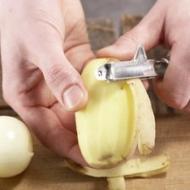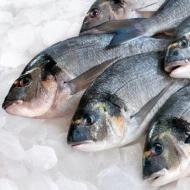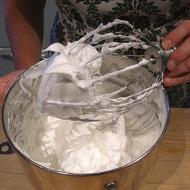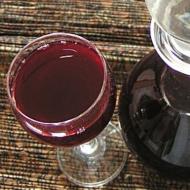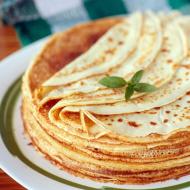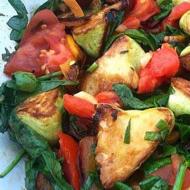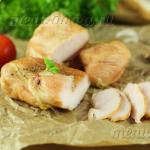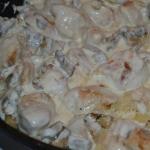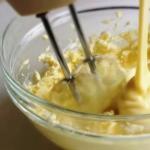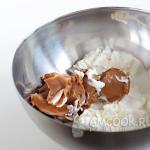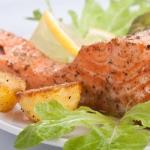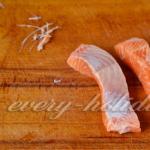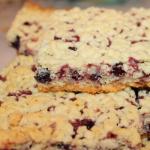
Delicate plum cake from the New York Times newspaper (correct recipe). The New York Times Plum Pie American Newspaper Plum Pie
The famous plum pie from The New York Times!
If you haven't tried it yet, give it a try ;)
Pie recipe (24 cm mold)
115 gr butter
150 gr sugar
a pinch of salt
2 eggs
120 gr flour
1 teaspoon baking powder
plums
1 tablespoon sugar
1 teaspoon cinnamon
Cream for serving
Good afternoon friends! Today we will talk about the legendary plum pie from The New York Times. The history of this cake is very interesting. If you are interested, be sure to read it on the Internet, but I want to tell you that the recipe for this pie was reprinted in this newspaper a huge number of times. Why is he so fond of American housewives? And the fact that it is prepared very simply, literally in a matter of minutes, and the products for its preparation can be found in any kitchen. It's plum season now, so this recipe will be especially relevant. It can also be cooked with other berries and fruits. I really like this pie with apricots and figs.
And so, there are several variations of this recipe, but I liked this one the most. We will need 120 grams of flour, 1 teaspoon of baking powder, 150 grams of sugar, 2 eggs, 115 grams of room temperature butter, a dozen plums, but the amount depends on their size. For sprinkling - 1 tablespoon brown sugar and 1 teaspoon cinnamon. If brown sugar is not available, use regular white sugar and add cinnamon if desired.
First of all, beat the butter, add a pinch of salt, sugar to the butter and beat at high speed for several minutes until bright and fluffy. The oil must be at room temperature, so take it out of the refrigerator in advance and let it warm up for about an hour or two. The optimum temperature for whipping butter is approximately 21 degrees. Beat the butter well, then add the eggs one at a time. Eggs should also be used at room temperature. After each addition, beat for a few minutes at high speed of the mixer. The butter and eggs are well beaten. Lush light mass should be the result. Now we will add dry products. Add baking powder to flour, mix and sift. Flour must be sifted in order to saturate it with air. Then the baking turns out to be more magnificent, more airy. Mix the dough until smooth and homogeneous. The dough is not too thick, but not runny either. Set it aside and start preparing the filling.
My plums, cut in half and remove the stone. Plums for the pie I like to use more dense and with a noticeable sourness.
Now we need a form with a diameter of about 24 cm. You can use a pie, biscuit, detachable form. I have a tart mold with a removable bottom. When baking, the form must be greased with butter.
We spread the prepared dough in the form, distribute it in a uniform layer in the form. Next, lay out the halves of the plums, slightly pressing into the dough. Sprinkle the top of the cake with a mixture of sugar and cinnamon. It is also recommended to sprinkle sweet fruits with a little lemon juice. We bake the cake in a preheated oven to 180 degrees for about 45-50 minutes.
Ready plum cake can be served both warm and cooled. It can also be frozen and reheated before serving. This pie goes great with a scoop of vanilla ice cream or whipped cream.
As you can see, the cake is very easy and quick to prepare. It turns out gentle, very fragrant and by all means will please you with the taste. Be sure to try it out!
The New York Times Plum Pie is a legendary pie with a very interesting history behind the recipe. American plum pie became a symbol of the passing summer for many Americans at the end of the last century. Marian Burroz, the author of the recipe, dedicated it to the plum season that had begun, which were sold everywhere at an attractive price. From 1983 to 1989, the New York Times published Marian Burros's recipe every September. Readers flooded the editorial office with letters of thanks and requests to print the recipe next season. After six years of publishing and a steady stream of reviews, the New York Times printed the plum pie recipe in large format and even circled it with a dotted line so that housewives finally cut it out and stop bothering the editors. After that, a statement was made about the last publication of the recipe in print. What started here! Angry letters poured in, with one reader explaining the significance of the pie's annual publication: “The appearance of this recipe is bittersweet, just like the pie itself. Summer is leaving, it is replaced by autumn. Your annual recipe epitomizes this. Don't be angry with us."
Since the first publication, the American Pie recipe has changed a bit. So, in the first version, 1 glass of sugar is indicated, and in the 1989 recipe, three-quarters of a glass. There are options with an apple and cranberries - other symbols of autumn. Then came the summer version of the recipe with blueberries and pears. What explains the popularity of plum pie? Its dough is very tender, with a creamy taste from the butter and with a crispy crust. The cake is prepared quickly, if not instantly. Products are always at hand. I adhere to the classic recipe and invite you to step by step cook with me a fragrant symbol of the outgoing summer. In the process, you can fantasize and add something to the recipe. I hope that for my readers, the publication of this pie will grow into something more than just a recipe.
- 3/4 st. sugar + 2 tbsp. for powder;
- 113 g butter;
- 1 st. flour;
- 2 eggs;
- 1 tsp baking powder for dough;
- a pinch of salt;
- 12 plum varieties prunes, Hungarian, etc.;
- 1 tsp cinnamon.

1. We select plums that can easily separate the stone from the pulp. Plums of the "Hungarian" and "prune" varieties are also very fragrant, dense and juicy. Cut the washed plums in half lengthwise and remove the pits. The classic recipe uses 12 small plums.

2. In a separate bowl, mix cinnamon and sugar for powder. If you cook a cake in a small form, about 20 cm in diameter, there is even a lot of this powder.

3. Combine sugar with eggs. The original recipe from 1983 says exactly 1 cup of sugar, but even with 2/3 cup the cake seems very sweet.

4. Beat everything into a homogeneous mass until bubbles appear.

5. Pour flour into beaten eggs. It is advisable to sift it. So we will saturate it with oxygen, and the cake will turn out to be truly airy. And with the help of a sieve, we will separate hard and foreign particles from the flour, which can spoil the taste of the cake. Now we fall asleep baking powder, a pinch of salt and put soft butter (you can margarine). For convenience, a couple of hours before preparing the cake, let the butter lie down at room temperature, and we will not have to resort to additional softening procedures. By the way, the original recipe says you don't need to add salt, but it's a natural flavor enhancer that won't hurt the cake.

6. Beat thoroughly dough whisk ohm. It is possible with a spoon, but it is longer and more difficult. The photo in the recipe shows that the consistency of the dough is thick, and the color depends on the eggs.

7. Not at the bottom b ol shoy r a earth form cover with parchment paper. Lubricate the walls with oil so that the cake separates well.
we cover the bottom of the detachable form with perg ament oh, grease the walls
oil painting

8. Put thick dough into the mold.

9. Level the mass with a spoon.

10. Lay the plums on top with the cut up so that they are well baked. From the halves of the plums, such “boats” are obtained, in which the fragrant plum juice will be retained. We do not press down the halves, in the process of baking they themselves will sink a little due to the fact that the dough will rise. If the fruits are large, you will need less than what is indicated in the list of ingredients. They all need to fit evenly into the mold.
This is what the original "Plum Torte" looks like. Photo www.nytimes.com
When this season I saw another article on the Russian-language Internet with the title "Plum Pie from The New York Times" ... I realized that I also have to say something about this, and even better, explain how it is there was in fact, because I always try to find out information first hand. the first mention of this recipe in this newspaper was on September 21(hereinafter I will designate the name of the newspaper as NT).
In my article, I will give real references to NT and a real, original, recipe for this pastry (and not even one, since it has official variations).
I baked THIS several times: with different plums and with other fruits, with and without cinnamon, with different amounts of sugar, incl. in the form of a sprinkle, with vanilla extract and almond, with white flour and whole grains, etc., etc. Moreover, she baked, not knowing about the existence of the famous "newspaper recipe", because the proportions of the ingredients in it are almost classic, they can be found in almost any cookbook on European and American pastries published in any language. This is the main secret of the popularity of this "plum pie".
Much of what you can read about this "plum pie" on the Russian-speaking Internet is a game of "broken phone". When I found out about the existence of a specific "American recipe", I studied all the original material about it, including separate culinary publications, except for the very first one, so I have something to say about both theory and practice.
***** ***** *****
Firstly, it is very easy to get acquainted with the original recipe., he: the latest version of the recipe and hundreds of user comments (link opens in a new window). If someone does not see anything on the link, then you need to register on the newspaper's website. In return, you will receive regular email alerts from the NT cooking column with new and old recipes, right with pictures (in English, of course). This cooking section also has paid material, and articles about "plum pie" can also be accessed from the browser through the search and the "backup" option.
Secondly, there are separate explanations about this pie both from its authors and from the newspaper itself. Articles in NT "The Story Behind Our Most Requested Recipe Ever", "5 Ways to Adapt Our Famous Plum Torte Recipe", "Crunchy-Topped Whole-Wheat Plum Cake", as well as various editions of "Elegant But Easy Cook Book" and book "The Essential New York Times Cookbook. Classic Recipes for a New Century" are the main sources for the recipe, its history and variations.
The true story, from beginning to end, can be found by simply typing "plum torte new york times" in a search engine: the very first links in the list should be the original data.
***** ***** *****
This pastry is originally called "Plum Torte", i.e. not "pie" (English "Pie / share"), but "Torte / cake". Very often on the foreign-language Internet it is called not "New York Times Purple Plum Torte", a "Marian Burros" Plum Torte or "Marian Burros and Lois Levine"s Purple Plum Torte". All because two main original recipes: one that was first published in the 1970s in a separate cookbook, and one that was already published in a newspaper in the 1990s. But they have one source: culinary columnist Marian Burros. She is never forgotten in NT and is always mentioned in connection with this pie. Unlike Runet, all recipes from foreign home cooks that I have been able to review also mention the name Marian, either in connection with NT or in connection with her cookbooks.
Marian Burros - American food columnist and writer. From 1974 to 1981 he was food editor of The Washington Post. Since 1981 he has been a reporter and since 1983 a columnist for The New York Times. She has published several cookbooks.

Marian Burros, now alive, lives in New York. Photo gettyimages.ca, ediblegreenmountains.com
This is the main thing, because this is the main thing :) And now - the details for those who, for some reason, cannot follow the links I have indicated.
Original Plum Torte recipe. The latest version with plums, published in The New York Times.
Scans from the official NT website


"Original Plum Torte"
Ingredients:
3/4 cup (150g) to 1 cup sugar (200g)
1/2 cup softened butter (113g - same as 1 stick of butter)
1 cup unbleached flour (120 g), sifted
1 tsp baking powder
a pinch of salt (optional)
2 eggs
24 purple plum halves
Sugar, lemon juice and cinnamon - for topping
Cooking:
1. Preheat oven to 175-180°C (350°F = 176.667°C)
2. In a bowl, mix sugar and butter until creamy. Add flour, baking powder, salt, eggs and beat well.
3. Put the dough into a springform pan with a diameter of 20, 22 or 25 cm. Put the plum halves on the dough with the skin side up. Sprinkle with sugar, sprinkle with lemon juice (depending on the sweetness of the fruit). Sprinkle with about 1 tsp. cinnamon (depending on how much you like cinnamon).
4. Bake for about 1 hour. Take out, cool (if desired, you can freeze). Serve warm or chilled, with whipped cream. Frozen cake must first be thawed and reheated at 150 °C.
Here at this link, which also leads to the NT page (date September 21, 2005), It is recommended to bake the cake for 40-50 minutes.
***** ***** *****
The same recipe, but with minor adjustments, was published by a food reviewer Amanda Hesser in 2010 in The Essential New York Times Cookbook, because more than 200 readers of the newspaper voted for its inclusion in the collection. Hesser herself called this recipe "almost perfect."



***** ***** ****
IMPORTANT!
The original recipes are given in American measuring cups (flour, sugar, butter) and "sticks" (stick; butter in some variations of the recipe), so Russian-speaking cooks who rewrite recipes from each other and indicate in the recipe 250 g of flour and "plums" cut up", I highly recommend studying the materiel, getting measuring cups, scales and using online converters to convert these same cups to grams and vice versa. Well, as always, I recommend very thoughtfully using "recipes from the Internet", especially from the "translated Russian".
1 measuring American cup is about 200 g of white sugar or 215-220 brown and 90 to 160 g of flour (depending on its type).
Converting different types of flour from cups to grams very detailed painted, for example. See the translation of other ingredients in the same place (link opens in a new window).
Fahrenheit to Celsius converter: here (link opens in a new window).
According to "settled", i.e. official Soviet measures, 1 faceted glass contains 180 g of sugar and 130 g of flour, 1 tea glass - 230 g of sugar and 160 g of flour. All such tables, even with drawings of glasses filled with flour, were still in Soviet cookbooks. If someone has other glasses, traditions and taste preferences, then ... I have nothing more to say about this.
***** ****** ******
How it all began. Marian received this recipe from her friend, with whom they published the first edition of the book "Elegant But Easy Cook Book" (authors Marian Fox Burros and Lois Levine). It was, according to various sources, either in 1960 or in 1962. In this book, the recipe is called "Fruit torte / Fruit cake".
The page with the original recipe from the very first edition of this book has not yet come across to me, so I do not know what, for example, flour was indicated there.

Photo www.nytimes.com
Almost 20 years later, when Marian became an NT columnist, she gave her version of this recipe on the pages of this newspaper. The very first mention of plum cake in NT is September 21, 1983. Link to the 1983 article (opens in a new window). The recipe for the pastry was printed in the context of a typical newspaper article: it lists 1 cup of sugar, simply "flour" and a 22cm pan.

Information about what happened next is also in the memoirs of Marian herself, and in numerous NT articles. The fact that the plum pie recipe was allegedly printed "20 years in a row, and then with the threats of an angry editor" was no longer mentioned or printed information about it in NT, as some Runet chefs think - this is incorrect information.
The recipe was published regularly in NT every September from 1983 to 1988. In 1989, the editors decided that this was enough: there was, as it were, the last time (with a warning about this) a version of the recipe was printed - in large print and so that it could be cut out. It was in this version that the amount of sugar was already reduced from 1 cup to ¾. Readers still kept asking for the plum cake recipe every year, so the authors and editors continued to work with it and constantly improved it.
In 1991, a new variation appeared from Marian herself: "New Age Plum Torte"(see further Part 2 of this article). In 1994 - a variation with cranberries and apples, although notes on recipes for replacing ingredients, incl. fruits have been made before. In total, this cake was mentioned in the newspaper 12 times. "Then newspaper clippings of recipes gave way to web pages and Pinterest boards. The pie found a new army of fans online," is a quote from the newspaper's official website.
In 2010 year the book "The Essential New York Times Cookbook," was published, which also contained a recipe for this cake. To include certain recipes in this edition, a survey was conducted among the readers of the newspaper. The book is very impressive: about 1500 pages, includes recipes from the middle of the 19th century to the present day.

Photo www.eat-drink-garden.com
Until now, year after year, the NT newspaper remembers this plum cake and almost regularly updates its recipe or gives links to old publications. Not to mention the fact that all the old articles and links on this topic, incl. with the original recipe and its variations, can be easily found on the official website of the newspaper.
In reissues of the book "Elegant But Easy Cook Book" these pastries are already called "Purple Plum Torte" and also provides several options for the recipe.
As far as I could understand, all variations of "Fruit Cake" are related to the personal preferences of their authors and readers. So, over time, the amount of sugar in the recipe was reduced and recommendations appeared to take unbleached flour, but Amanda Hesser points to all-purpose flour and says that 1 cup of sugar and plums is, from her point of view, the best option and that there are no innovations here needed.
I repeat: what the very first version looked like - the version of the 1970s - I don’t know yet, but this, by and large, does not matter anymore, because this recipe has been edited many, many times by ourselves since then and taking into account modern realities authors and their fans.
Plums seem to be specially created for baking - it is in combination with sweet dough that they fully reveal their taste! This cake seems to be one of the most successful options for plum baking. According to legend, his recipe was published for a long time in the New York Times at the request of housewives. True or not, we do not know, but the plum cake is quite worthy of such popularity. It is prepared very easily and quickly, and the taste is just great!
- Recipe author: Anna Atai
- After cooking, you will receive 8
- Cooking time: 1 hour
Ingredients
- 300 gr plum
- 120 gr butter
- 110 gr sugar
- 2 pcs. egg
- 90 gr wheat flour
- 7 gr. dough baking powder
- 2 tbsp brown sugar
- 1/2 tsp ground cinnamon
Cooking method
Remove butter and eggs from the refrigerator in advance - they should be at room temperature. Turn on the oven to heat up to 180 degrees. Cut each plum in half and remove the pit. Grease a 23cm mold with butter.
Mix the rest of the butter together with sugar with a whisk.
Add eggs one at a time, mix again with a whisk or mixer.
Separately mix flour and baking powder. Pour the flour into the butter mixture, mix with a whisk.
Pour the dough into a mold (it is quite thick). Arrange the plums on top, cut side up, without pressing them into the batter. Mix brown sugar and cinnamon. Sprinkle the pie with this mixture.
Put the mold in the oven for 40-50 minutes. Readiness to check with a toothpick. If a toothpick inserted in the middle of the cake comes out completely dry - plum pie ready.
Enjoy your meal!
It will seem to someone that the pie is similar to charlotte - not that real bread, but apple, pear, with apricots, any seasonal fruits, filled with a viscous dough. In general, yes. Only there fruits / stone fruits are mixed, due to which the crumb is saturated with juice and moistened. For the New York Times plum pie, it's important to spread the plums on top of the dough.
If you want to fix the halves without drowning them in the flour mass and create a beautiful plum cake from the New York Times newspaper, choose a large diameter mold and do not increase the baking powder. The best fruits are firm, fleshy and freshly sour.
Prep time: 70 minutes / Serves: 8-10 / 28cm diameter mold
Ingredients
- wheat flour 230-250 g
- sugar 200 g
- butter 120 g
- eggs 2 pcs. large size
- baking powder 1 tsp
- pinch of salt
- cinnamon 1-2 tsp
- plums 10-12 pcs.

Cooking
Large photos Small photos
Butter before kneading should be melted, soft, it is better to transfer it from the refrigerator to the table in a couple of hours. In the original recipe, it is butter that is indicated, it is clear that replacing with margarine will reduce the quality of baking.
We measure out 180 g of granulated sugar (the remaining 20 g are needed for sprinkling and caramelization on top), rub with pliable butter. Work with convenient improvised means: a fork, spatula or mixer. If the latter, it is important not to interrupt, otherwise the oil will curdle and whey will stand out. Bring to a creamy smooth consistency.

Next, we drive in the eggs, preferably one at a time, each time mixing into the mass until completely combined. Note that more small eggs will be needed - not two, but three. Or reduce the amount of wheat flour (in the third step add flour gradually). The simplicity of the process is obvious. There is no need to separate and beat egg whites and yolks alternately. Elementary bookmark sequence and kneading in three minutes.

We throw a pinch of salt, shading the sweetness. Sift the first 200 g of flour mixed with baking powder. Then we change the fork to the whisk and intensively draw in a circle. The remaining 30-50 g are added along the way. Adjust more or less yourself, the texture of the dough should come out sticky, but not liquid, as for charlotte.

We grease the refractory form with a thin layer of oil, fill it with a smooth dough - we level it with a spatula along the entire bottom so that the thickness of the cake is the same everywhere. With a smaller container diameter, the crumb will rise higher. Also, in addition to the round configuration, the cake is rectangular, square - use a proven shape, from which products are easily separated.
Sweet and sour, dense plums, wash and dry.

We tear the plums with our hands or cut them into neat halves, remove the seeds. We lay the halves in a circle with a small equal distance or closely to each other. Mandatory position - cut up. So the released juice will not completely spread over the dough and the crumb will not be wet as a result.

The sourness of stone fruits will increase during baking, so we additionally sprinkle with the remaining 20 g of granulated sugar, flavor with ground cinnamon. Warm spice with plums, apricots, peaches is no worse than with traditional apples. The fruits are enriched with cinnamon aroma, slightly caramelized due to sugar, release juice, soften, while remaining in place and successfully combined with a delicate creamy crumb, both externally and in taste.

We bake the New York Times plum pie in a preheated oven for about 50 minutes, until a “dry match”, we maintain the temperature at around 170-180 degrees. Cool down in shape.
We serve a New York Times pie with tea, fruit drinks or compotes. Enjoy your meal!




